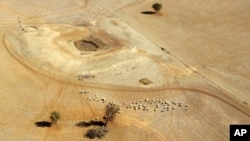New research reveals puddles that dry in the sun and re-form with the next rain mimic the environment in which life on our planet could have formed.
Scientists at the Georgia Institute of Technology say that on the early Earth amino and hydroxy acids combined and were then subjected to cycles of wet and dry conditions. Over time, that chemical reaction formed polypeptides - the building blocks of life.
The work supports the theory that life could have begun on dry land, where cool moist nights were followed by heat and evaporation under the sun. Reporting in the German journal Applied Chemistry (Angewandte Chemie), the researchers say they were able to form complex polypeptides in the lab after just 20 wet-dry cycles.
Center for Chemical Evolution Director Nicholas Hud said his lab's work offers a more plausible explanation for peptide formation than previous theories - which involved high temperatures incompatable with life and the questionable presence of activating chemicals on the early Earth.










